University students around Ontario withdrew from classes to protest

Ryerson students joined community allies and campuses across Toronto for a one-day strike downtown Wednesday. Roughly 100 demonstrators converged at Queen’s Park from various post-secondary schools and groups around the city, including the University of Toronto-Mississauga, the OCAD Student Union, the Ontario Public Service Employees Union, CUPE 1281 and the Ontario Federation of Labour.
Among the Ryerson Student Strike Committee’s demands were restoring full pre-Ford OSAP funding, a complete elimination of tuition fees, repealing the Student Choice Initiative, a cancellation of all student debt, a ban on unpaid labour and the creation of paid work placements.
The committee, made up of members from Socialist Fightback at Ryerson, has been working toward a student strike since early September, though it was unclear if the Ryerson Students’ Union and CESAR would officially support the strike, citing equity concerns while waiting on responses from an emailed survey.
Kwaku Agyemang, the RSU’s vice-president education, says that a majority of students responded to the RSU survey in support of a student strike in the form of the Nov. 6 action.
CESAR president Nicole Brayiannis also said that their survey results saw a majority of students select a one-day strike. On Oct. 30, the RSU and CESAR joined the committee to announce support for yesterday’s strike.
“All my professors have been really supportive,” said Hayley Adams, a student in Olivia Chow’s Community Action Research class at Ryerson. Adams said that another professor of hers posted an online lecture for students who wanted to miss class to join the strike.
Adams was with a group of several other students from Chow’s class. She said that it made sense for them to get together and “do something active as opposed to just talking about it.”
Today’s actions mirror similar campus demonstrations against the education reforms that Premier Doug Ford and former minister of training, colleges and universities Merrilee Fullerton announced in January.
Among those changes were reductions in provincial grants — which were only accessible after applying for OSAP loans — as well as the introduction of the Student Choice Initiative. The SCI lets individual students opt out of services that have already been voted on in campus referenda, such as the World University Services Canada Refugee Program or the Eyeopener newspaper.
Ottawa Centre NDP MPP Joel Harden made an appearance at the Queen’s Park rally in support of the students. “I refuse the idea that we can’t have access for every single person to education in the province — without tuition,” Harden said to the Ryersonian.
“We have to continue to keep the pressure up on all political parties, including mine,” he added, explaining that while NDP members have passed free tuition resolutions at conventions, free tuition has not been prioritized in platforms during elections.
“I find it stunning that we can lavish hundreds of thousands of dollars on the people who run our post-secondary institutions… and yet people this year, because of the OSAP cuts, are deciding not to go back to school,” he added. At Ryerson, the top 10 highest-paid employees collectively made more than $3 million in 2018, according to the Public Sector Salary Disclosure.
Ryerson Student Strike Committee member Olive Pape said in a statement that the movement needs to expand to other sectors of labour, adding that the group hopes to organize another strike with student union support in the new year.
“Next semester, we’re hoping to hold another day of action,” said Brayiannis, adding that today’s turnout included students from Ryerson, York, the University of Toronto-Mississauga, Lakehead University, Windsor University and OCAD. “We’re going to communicate with other campuses and try to grow it again.”

